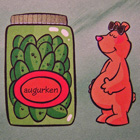
Niet dat de foetus dus mee-eet via het vruchtwater, dat gaat namelijk via de placenta, maar we veronderstellen dat de foetus het vruchtwater drinkt voor zijn plezier. Wat betekent dat de moeder haar kind kan plezieren met haar eten!

Zodra het kind geboren is, drinkt het kind moedermelk en daarmee zet hij de oefening van zijn smaak voort. Moedermelk varieert in smaak, afhankelijk van wat de moeder gegeten heeft. Daarom is ook het idee dat een moeder na de bevalling niet haar eetgewoonten zou moeten veranderen. Een plotselinge verandering zou de jonge zuigeling in verwarring kunnen brengen.
En ook al begint de smaakontwikkeling dus al heel vroeg, hij blijft zich ontwikkelen tot de leeftijd van drie jaar en hij zorgt mogelijk voor een levenlang plezier en passie.
Artikelinformatie
- met toestemming overgenomen van: Destination Santé, health news agency
- © 1996-2007 Destination Santé SAS
- Lees hieronder het artikel in het Engels en het Frans
Taste develops even before birth

The tastes that occur most commonly in the amniotic fluid register in the foetus’s memory and when the baby is born it will have a preference for these flavours. So the education of the palate begins very early indeed! Before it has ever eaten food, an infant can differentiate between sweet, bitter and sour. And it’s sweet that the baby prefers, for an elementary reason: in nature, bitter and sour are often associated with toxic substances. So, from the moment we’re born, our survival instinct attracts us to sweet tastes, as they are not associated with danger.
Once an infant is born, the education of its taste buds continues through breast milk: breast milk varies in taste according to what the mother eats, unlike artificial baby milk. Breastfeeding mothers should not alter their eating habits once they have given birth. A sudden change could well confuse their newborn baby, who might then refuse to breastfeed. For instance, if you didn’t eat cabbage while pregnant, don’t start eating large amounts of it immediately afterwards! Although our sense of taste begins to form very early on, it continues developing until the age of three. And of course it’s something that should remain a lifelong pleasure and passion.
Le goût, avant même la naissance

Les goûts qui reviennent souvent dans le liquide amniotique s’enregistrent dans sa mémoire. A sa naissance le nouveau-né aura un penchant pour ces saveurs. L’éducation du palais débute donc très tôt ! Aussi, sans avoir jamais reçu de nourriture, un nourrisson sait différencier le sucré, l’amer et l’acide. C’est le sucré qui emporte sa préférence, pour des raisons primaires : dans la nature, l’amer et l’acide sont souvent toxiques. C’est donc par instinct de conservation que dès la naissance nous sommes attirés par le sucre, censé ne pas présenter de danger.
Après la naissance, le lait maternel prolonge cette éducation des papilles : le lait change de goût suivant l’alimentation de la mère, contrairement aux laits industriels. Les mamans qui allaitent ne doivent pas modifier leurs habitudes alimentaires après l’accouchement. Un changement brutal risquerait de dérouter Bébé, qui refuserait alors le sein. Exemple : si vous n’avez pas consommé de chou pendant la grossesse, ne vous jetez pas dessus les premiers jours ! Si le goût se forme très tôt, il s’apprend jusqu’à trois ans. Mais c’est aussi une éducation passionnante qui se poursuit toute la vie.
